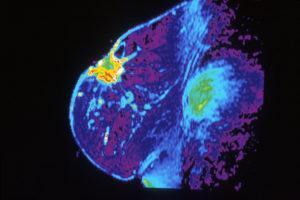
Title MRI of Breast Description Color-enhancement show magnetic resonance image (MRI) of individual breast. Topics/Categories Anatomy — Breast Test or Procedure — Imaging Procedures Type Color, Photo Source Dr. Steven Harmes. Baylor University Medical Center, Dallas Texas (Source: WIkimedia Commons)
Breast cancer has affects millions globally and remains the highest cause of women death due to cancer. The cause of breast cancer is heterogenous and are related to genetics, obesity, hormones and age. The danger of the disease is that it can go undetected while causing uncontrollable epithelial cell growth within the breast duct lining spreading throughout the breast tissue and metastasizing to other organs.
Early detection of breast cancer offers curable options, however, once metastasized the cancer cannot be cured. With higher rates of breast cancer correlated with western diet consumption, there are important metabolic underpinnings that lead to development of breast cancer and metastasis. The Warburg effect outlines the metabolic mechanism behind a high-fat diet leading to further metastasis. The importance of studying lipid profiles remains a goal to develop interventions that slow breast cancer malignancy. Scientists previously have identified reduced breast cancer malignancy by transitioning breast duct lining cells (epithelial cells) to adipocytes (mesenchymal cells), the process known as epithelial-mesenchymal transition (EMT). The current successes of EMT with reducing metastasis has offered a metabolic solution by causing breast cancer cells to transition to adipocytes.
Study by Kang et al., 2019 used breast cancer cells transitioned to adipocytes using spheroid cellular culture and analyzed the lipidomic profile of post-transition cells compared to control. Overall, the transition identified a significant change within the cellular metabolic profile. Spheroid-induced transition cells had increased ceramide, an indicator of reduced aggressiveness of breast cancer and decreased ether-linked glycophospholipids consistent with reduced breast cancer. Additional ratio changes were observed in fatty acids with increases seen of C16:1 fatty acids vs. C18:2 and significant decreases of monounsaturated fatty acid (MUFA) enzymes and increased polyunsaturated fatty acid (PUFA) enzymes. Gene expression changes were also determined from the culture, stearoyl-CoA desaturase was increased (MUFAs) while enzymes -protein tyrosine phosphatase-like member B, longation of very long-chain fatty acid 2 (ELOVL2) and peroxisomal trans-2-enoyl-CoA reductase- were decreased (PUFAs).
These findings are important because previous studies have shown that cancer cells preferentially utilize glycolysis and lactate fermentation favouring hypoxic metabolism. These results show that breast cancer cells that transition to adipocytes and are less malignant gain higher PUFA enzyme ability along with increased glutaminolysis and serine/glycine biosynthesis.
Scientists identified one key factor that contributed to breast cancer malignancy, ELOVL2, a key PUFA enzyme. It was determined that decreased ELOVL2 leads to increased breast cancer offering the factor as a potential modulator of fat metabolism and preventing metastasizing breast cancer.
Thus with conventional cancer treatment, diet may have a role in preventing malignant breast cancer. Furthermore, patients who had lowered ELOVL2 due to a small nucleotide polymorphism and subsequent PUFAs found fish oil supplementation alleviated the genetic deficiency. The study also outlined the importance of understanding patient’s lipid profile to prevent malignant breast cancer types. Highlighting the benefits of exercise providing therapy through the increase of related genes to PUFA production, ELOVL2, ELOVL3 and 4, which were drastically increased from exercise.
Journal Article: Kang et al. “Spheroid-induced epithelial-mesenchymal transition provokes global alterations of breast cancer lipidome: A multi-layered omics analysis.” Frontiers in Oncology 9 (2019): 145.
Article by Sohail H. Mahmood
References:
- AlSaleh, Aseel, et al. “ELOVL2 gene polymorphisms are associated with increases in plasma eicosapentaenoic and docosahexaenoic acid proportions after fish oil supplement.” Genes & nutrition 9.1 (2014): 362.
- Marro, M., et al. “Molecular monitoring of epithelial-to-mesenchymal transition in breast cancer cells by means of Raman spectroscopy.” Biochimica et Biophysica Acta (BBA)-Molecular Cell Research 1843.9 (2014): 1785-1795.
- May, Francis J., et al. “Lipidomic adaptations in white and brown adipose tissue in response to exercise demonstrate molecular species-specific remodeling.” Cell reports 18.6 (2017): 1558-1572.
- Tham, Yow Keat, et al. “Lipidomic profiles of the heart and circulation in response to exercise versus cardiac pathology: a resource of potential biomarkers and drug targets.” Cell reports 24.10 (2018): 2757-2772.











